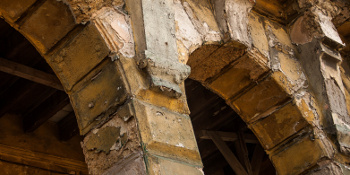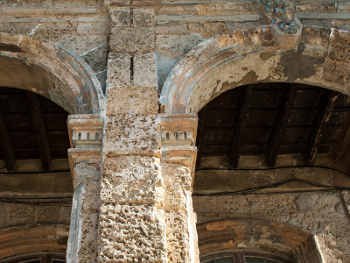Salt Corrosion
October 1, 2014
As my name might indicate, I have a special attraction to
Italian food. My addiction in that regard was fueled first by my
mother, who, despite being of
Polish ancestry, is an excellent Italian
cook. Since then, I've been happily
married to another excellent cook. As they say,
the way to a man's heart is through his stomach.
For that reason I noticed a recent article about the
Olive Garden, a
chain restaurant serving
Italian-American food.[1] According to a lengthy criticism of the restaurant
management by a
hedge fund, the restaurant is not
salting the cooking
water for
pasta, since unsalted water allows it to get an extended
warranty on its
pots.[1] Every cook knows that pasta water is salted for better
taste.

Spaghetti Bolognese
Bolognese sauce is a meat sauce that's commonly served with lasagna.
There's a Wikibooks recipe for Bolognese sauce available online.
(Via Wikimedia Commons.)
From a
materials perspective, it's easy to see why such a warranty would be offered. Salt, especially in a
high temperature solution, is
corrosive, so much so that a
salt spray test is used to access the
corrosion resistance of materials. According to
ISO 9227, "Corrosion tests in artificial atmospheres - Salt spray tests," the material is sprayed with a
sodium chloride (NaCl) solution of 50
grams per
liter at 25°
C.[2]
The
gas turbine engines of
airliners are subject to a particular type of salt corrosion known as high-temperature hot corrosion (HTHC, also known as Type I corrosion) that's caused by the presence of salts such as sodium chloride and
sodium sulfate (Na
2SO
4) in the
air, especially in
marine environments.[3]
At the operating temperature of these engines, the salts are
molten (sodium chloride has a
melting point of 801°C), and they attack the protective
oxide layers of the
superalloy turbine blades.[3] Although
sea air is a common source of such salt, it can also come from
industrial pollution and
volcanic eruptions, so now you know why the
Iceland volcanoes disrupt
air travel.
Architectural stonework, as well as
metals, are subject to salt corrosion. A team of
scientists from the
Eidgenössische Technische Hochschule Zürich (Zürich, Switzerland),
Sika Technology AG (ETHZ, Zürich, Switzerland), and
Princeton University (Princeton, New Jersey) has examined the process by which
porous building materials are damaged by the
pressure exerted by salt
crystals growing in their pores.[4-6]
As anyone who had had a favorite
flowerpot or other container
crack when retained water
solidifies into
ice knows, solidification can exert pressure. Older buildings, some of
historical significance, often age because of the action of salt. Salts,
crystallizing inside the pores of building materials, can generate enough
force to break the
stone. This effect occurs not just in natural stone, but also in the
concrete of modern structures. The
research team is doing
experiments to test the action of salts under controlled conditions in an attempt to predict such
weathering.[6]

An older building showing signs of salt corrosion in Havana, Cuba.
(Photo by Julio Llopiz/ETH Zurich.)[6)]
As
Francesco Caruso, a
post-doctoral researcher at ETHZ explained in a press release,
cement, a component of concrete, always contains the sulfate salt,
calcium sulfate, commonly called
gypsum, and other and
alkali sulfates. Environmental salt can enter the materials by
capillary action from
mineralized groundwater.
Sulfur dioxide, a common air pollutant, will react with the
calcium carbonate in
limestone to form gypsum.[6] Furthermore, says Caruso,
"If [de-icing salt and seawater spray] are dissolved by rain, the saline liquid can enter the building material through pores and cracks."[6]
As the liquid
evaporates, such salts crystallize to cause the stonework to crumble.[6]
In the
laboratory simulation of the process, the research team placed two-
centimeter cubes of limestone in sodium sulfate solution. After the salt solution
permeated the limestone pores, they dried the specimens at high temperature, then repeated the process again and again. The salt accumulated in the pores as
anhydrous sodium sulfate, and the repeated cycling allowed the formation of a
supersaturated salt solution in the poses from which crystallites will grow.[4,6]

Salt corrosion damage to a building in the older section of Havana, Cuba.
(Photo by Julio Llopiz/ETH Zurich.)[6)]
Not unexpectedly, the higher the supersaturation, the greater the corrosive effect. The lowest point of the temperature cycle was also a big factor. If the temperature never went below 25°C, about four cycles were required for damage to occur. However, when the temperature dropped to 3°C, damage was apparent after a single cycle.[6]
Such research findings are important, also, in the
preservation of
frescos, such as
Michelangelo's frescos in the
Sistine Chapel.[6] The effect has been noted, also, in
geology. In 2007, the
ground of part of
Staufen im Breisgau, Germany, rose by about a
foot, since
geothermal drilling had allowed groundwater to entered a deposit of anhydrous calcium sulfate to form gypsum. This generated enough pressure to lift the ground.[6]
References:
- Jordan Weissmann, "Olive Garden Has Been Committing a Culinary Crime Against Humanity," Slate, September 12, 2014.
- International Organization for Standardization, ISO 9227:2012, Corrosion tests in artificial atmospheres -- Salt spray tests.
- N. Eliaz, G. Shemesh, and R.M. Latanision, "Hot corrosion in gas turbine components," Engineering Failure Analysis, vol. 9, no. 1 (February 2002), pp. 31-43. A PDF file is available here.
- Robert J. Flatt, Francesco Caruso, Asel Maria Aguilar Sanchez, and George W. Scherer, "Chemo-mechanics of salt damage in stone," Nature Communications, vol. 5, article no. 4823 (Online publication, September 11, 2014), doi: 10.1038/ncomms5823.
- Supplementary information for ref. 4.
- Fabio Bergamin, "How salt causes buildings to crumble," Eidgenössische Technische Hochschule Zürich Press Release, September 11, 2014.
Permanent Link to this article
Linked Keywords: Italian cuisine; Italian food; mother; Polish ancestry; cooking; cook; marriage; married; the way to a man's heart is through his stomach; Olive Garden; restaurant chain; chain restaurant; Italian American cuisine; management; hedge fund; salting; water; pasta; warranty; cookware and bakeware; pot; taste; Spaghetti Bolognese; Bolognese sauce; meat; sauce; lasagne; lasagna; Wikibooks recipe; Wikimedia Commons; material; high temperature; aqueous solution; corrosion; corrosive; salt spray test; corrosion resistance; International Organization for Standardization; ISO; sodium chloride; gram; liter; celsius; gas turbine engine; airliner; sodium sulfate; air; ocean; marine environment; melting; molten; melting point; oxide; superalloy; turbine blade; sea air; industrial; air pollution; volcanic eruption; Iceland volcanoes; air travel; architecture; architectural; stonemasonry; stonework; metal; scientist; Eidgenössische Technische Hochschule Zürich (Zürich, Switzerland); Sika Technology AG (ETHZ, Zürich, Switzerland); Princeton University (Princeton, New Jersey); porosity; porous; pressure; crystal; flowerpot; fracture; crack; freezing; solidify; ice; history; historical; crystallization; crystallizing; force; rock; stone; concrete; research; experiment; weathering; Havana, Cuba; Julio Llopiz/ETH Zurich; Francesco Caruso; postdoctoral research; cement; calcium sulfate; gypsum; alkali metal; capillary action; mineral; mineralize; groundwater; sulfur dioxide; calcium carbonate; limestone; evaporation; evaporate; laboratory; centimeter; cube; permeation; permeate; anhydrous; supersaturation; supersaturated; historic preservation; fresco; Michelangelo; Sistine Chapel; geology; soil; ground; Staufen im Breisgau, Germany; foot; geothermal drilling.